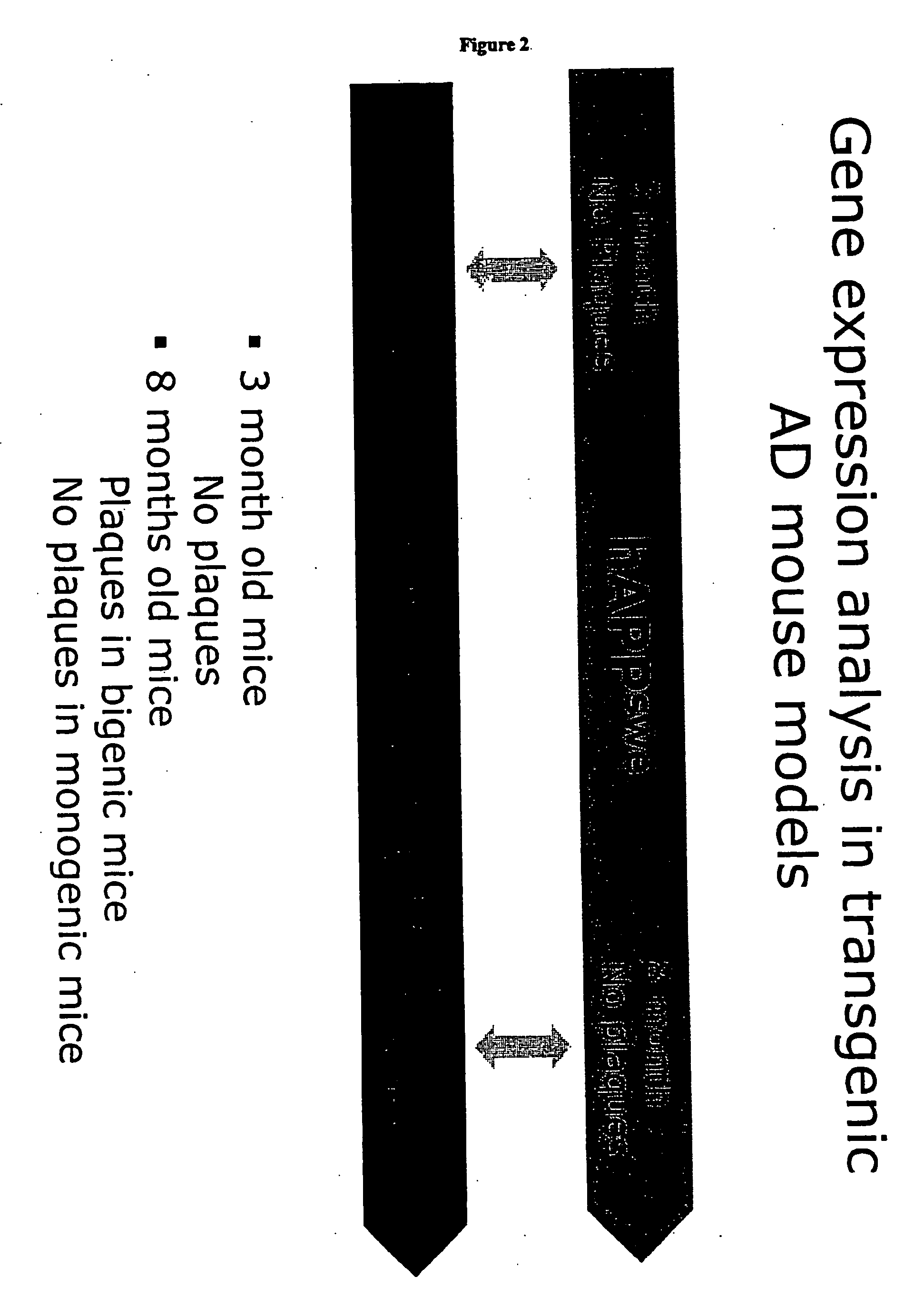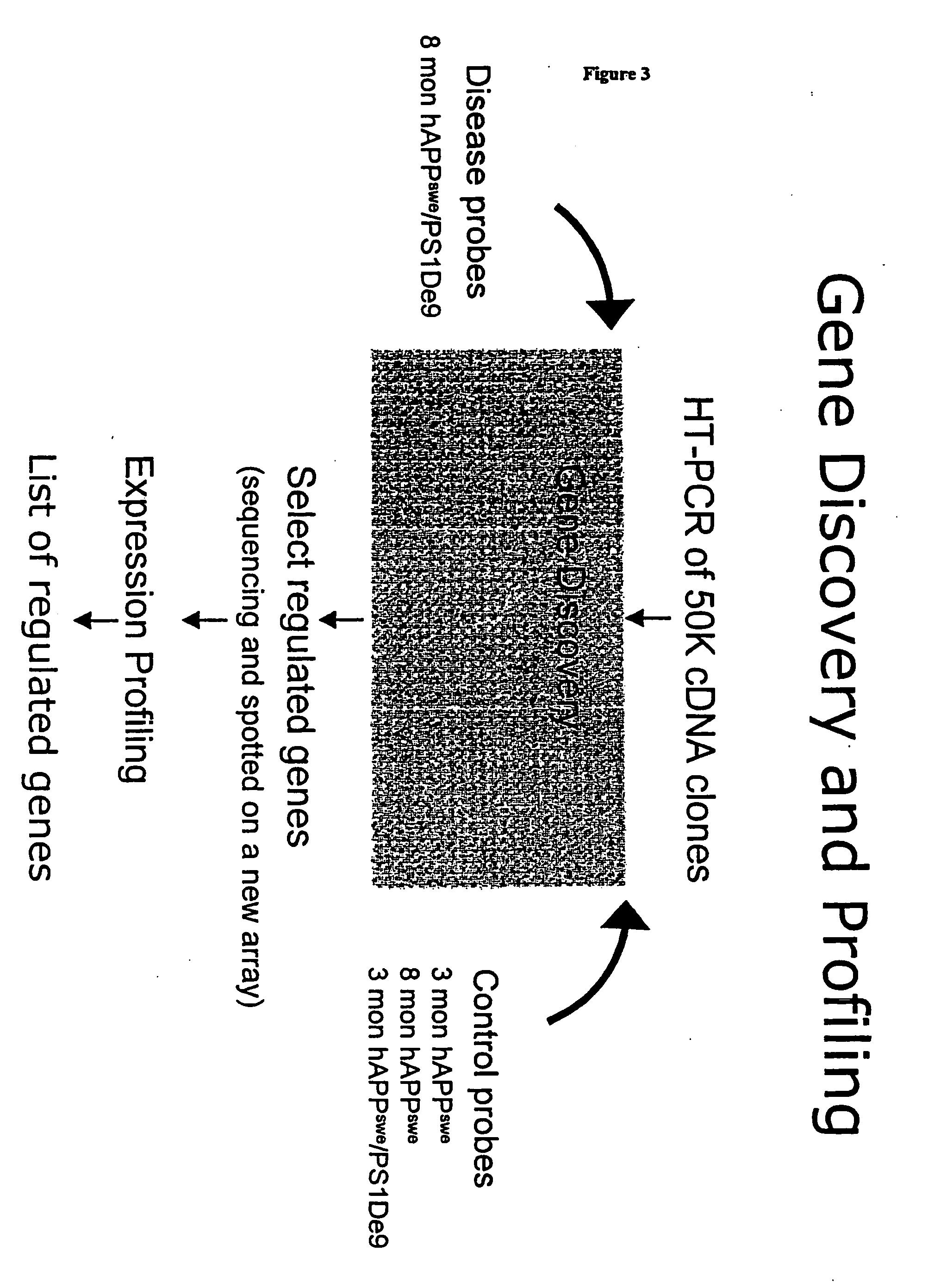Regulated nucleic acids in pathogenesis of alzheimer's disease
a technology of alzheimer's disease and nucleic acids, applied in the field of gene analysis, can solve the problems of imposing an enormous cost on the society, progressive deterioration of certain brain regions and neuronal cells manifesting with memory failure, disorientation and confusion, and the molecular basis of neuronal cell loss is far from being fully elucidated, so as to facilitate the development of agents or modulators
- Summary
- Abstract
- Description
- Claims
- Application Information
AI Technical Summary
Benefits of technology
Problems solved by technology
Method used
Image
Examples
example 1a
Identification of AD-Associated Genes using Subtractive Hybridization
[0196] A BV-2 (mouse microglia cell line) culture is divided into two cultures. To one culture is added toxic Aβ peptide and to the other is added a non-toxic negative control. Samples from the cultures are collected at different time points after addition of the Aβ peptide. The whole mRNA of the samples are extracted and used to generate a cDNA library. The cDNA members of the cDNA library generated from the control culture is attached to a solid support or beads. The cDNA members of the cDNA library generated from the Aβ-activated culture is then hybridized to the cDNA members of the attached cDNA library. The non-hybridized or free cDNA members are then separated from the hybridized cDNA members by exploiting the properties of the solid support or beads. The non-hybridized or free cDNA members are pooled or collected and this pool or collection is a subtractive cDNA library of genes wherein the expression of th...
example 1b
Identification of AD-Associated Genes using the in vivo Aβ-Deposition Model
[0199] As noted above, one of the major pathological hallmarks of Alzheimer's Disease (AD) is senile plaques, in which amyloid β peptide is the major component. Mutations in amyloid precursor protein (APP) and presenilin (PS) are known to elevate Aβ levels and cause autosomal dominant familial AD (FAD). Bigenic mice (designated hAPPswe×hPS1ΔE9) overexpressing FAD-linked APPsw (K595N, M596L) and PS1ΔE9 (APPswXPS1ΔE9) develop amyloid plaques at as early as 5-6 months, while mice expressing APPsw (designated hAPPswe) develop plaques much later. By comparing the gene expression profiles of the brain tissues derived from these two models, we are able to identify a large number of genes associated with the early onset and / or progress of AD.
[0200] Specifically, we used normalized cDNA libraries with more than 50,000 clones were generated from mouse hippocampal or cortical regions for gene profiling. PCR inserts fr...
example 1c
Identification of AD-Associated Genes using the “Artificial Plaque” Model
[0202] Amyloid β peptide is introduced into the rat brain by injecting human Aβ1-42 conjugated polystyrene beads unilaterally. The contralateral side was injected with control beads conjugated with rat Aβ-42 or the reverse peptide designated as human Aβ42-1. The polystyrene beads are fluorescent and can be microscopically visualized. About 10 days after the injection, there is significant neuronal loss in the hippocampal region surrounding the site injected with human Aβ1-42 beads, while no significant neuronal loss was observed in the hippocampus injected with rat Aβ-42 or human Aβ42-1 beads. Understanding the process of this human Aβ1-42 mediated neuronal loss provides important information for understanding AD pathogenesis. This invention describes the identification and characterization of key proteins involved in the human Aβ1-42 induced neuronal loss in this model system.
[0203] A normalized rat hippocam...
PUM
| Property | Measurement | Unit |
|---|---|---|
| temperature | aaaaa | aaaaa |
| temperature | aaaaa | aaaaa |
| neurodegenerative disorder | aaaaa | aaaaa |
Abstract
Description
Claims
Application Information
 Login to View More
Login to View More - R&D Engineer
- R&D Manager
- IP Professional
- Industry Leading Data Capabilities
- Powerful AI technology
- Patent DNA Extraction
Browse by: Latest US Patents, China's latest patents, Technical Efficacy Thesaurus, Application Domain, Technology Topic, Popular Technical Reports.
© 2024 PatSnap. All rights reserved.Legal|Privacy policy|Modern Slavery Act Transparency Statement|Sitemap|About US| Contact US: help@patsnap.com










